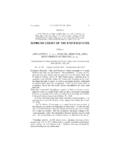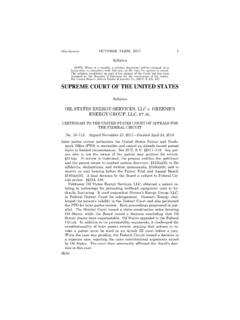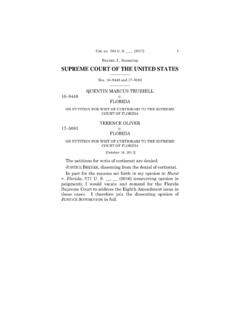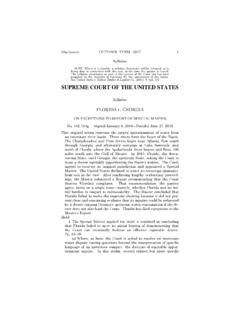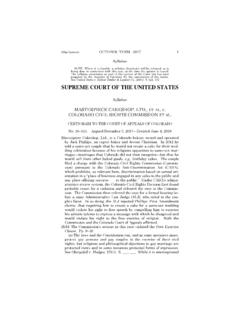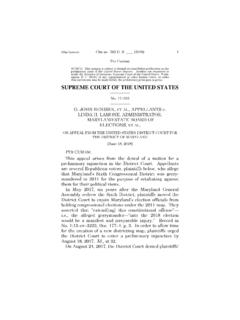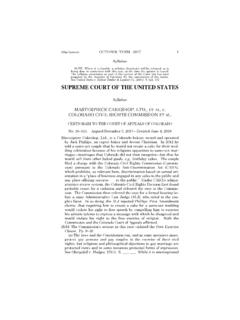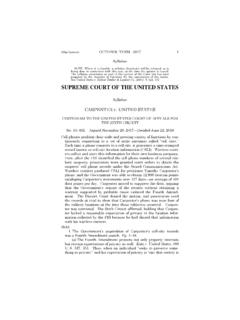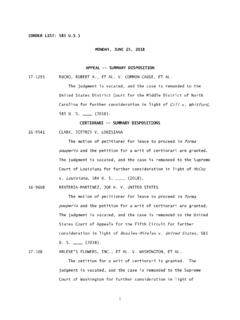Transcription of R SUPREME COURT OF THE UNITED STATES
1 _____ _____ 1 Cite as: 594 U. S. ____ (2021) ROBERTS, C. J., dissenting SUPREME COURT OF THE UNITED STATES No. 21A24 WHOLE WOMAN S HEALTH ET AL. v. AUSTIN REEVE JACKSON, JUDGE, ET AL. ON APPLICATION FOR INJUNCTIVE RELIEF [September 1, 2021] The application for injunctive relief or, in the alternative,to vacate stays of the district COURT proceedings presentedto JUSTICE ALITO and by him referred to the COURT is de-nied. To prevail in an application for a stay or an injunc-tion, an applicant must carry the burden of making a strong showing that it is likely to succeed on the merits, that it will be irreparably injured absent a stay, that the balance of the equities favors it, and that a stay is con-sistent with the public interest. Nken v. Holder, 556 U. S. 418, 434 (2009); Roman Catholic Diocese of Brooklyn v. Cuomo, 141 S. Ct. 63, 66 (2020) (citing Winter v. Natural Resources Defense Council, Inc.)
2 , 555 U. S. 7, 20 (2008)). The applicants now before us have raised serious questions re-garding the constitutionality of the Texas law at issue. But their application also presents complex and novel anteced-ent procedural questions on which they have not carried their burden. For example, federal courts enjoy the power to enjoin individuals tasked with enforcing laws, not the laws themselves. California v. Texas, 593 U. S. ___, ___ (2021) (slip op., at 8). And it is unclear whether the named defendants in this lawsuit can or will seek to enforce the Texas law against the applicants in a manner that might permit our intervention. Clapper v. Amnesty Int l USA, 568 U. S. 398, 409 (2013) ( threatened injury must be certainly impending (citation omitted)). The State has represented 2 WHOLE WOMAN S HEALTH v. JACKSON ROBERTS, C. J., dissenting that neither it nor its executive employees possess the au-thority to enforce the Texas law either directly or indirectly.
3 Nor is it clear whether, under existing precedent, this COURT can issue an injunction against state judges asked to decide a lawsuit under Texas s law. See Ex parte Young, 209 U. S. 123, 163 (1908). Finally, the sole private-citizen respondent before us has filed an affidavit stating that he has no pre-sent intention to enforce the law. In light of such issues, we cannot say the applicants have met their burden to prevail in an injunction or stay application. In reaching this con-clusion, we stress that we do not purport to resolve defini-tively any jurisdictional or substantive claim in the appli-cants lawsuit. In particular, this order is not based on any conclusion about the constitutionality of Texas s law, and in no way limits other procedurally proper challenges to the Texas law, including in Texas state courts. CHIEF JUSTICE ROBERTS, with whom JUSTICE BREYER and JUSTICE KAGAN join, dissenting. The statutory scheme before the COURT is not only unu-sual, but unprecedented.
4 The legislature has imposed a prohibition on abortions after roughly six weeks, and then essentially delegated enforcement of that prohibition to the populace at large. The desired consequence appears to be to insulate the State from responsibility for implementing and enforcing the regulatory regime. The State defendants argue that they cannot be re-strained from enforcing their rules because they do not en-force them in the first place. I would grant preliminary re-lief to preserve the status quo ante before the law went into effect so that the courts may consider whether a state can avoid responsibility for its laws in such a manner. De-fendants argue that existing doctrines preclude judicial in-tervention, and they may be correct. See California v. Texas, 593 U. S. ___, ___ (2021) (slip op., at 8). But the con- 3 Cite as: 594 U. S. ____ (2021) ROBERTS, C. J., dissenting sequences of approving the state action, both in this partic-ular case and as a model for action in other areas, counsel at least preliminary judicial consideration before the pro-gram devised by the State takes effect.
5 We are at this point asked to resolve these novel ques-tions at least preliminarily in the first instance, in thecourse of two days, without the benefit of consideration by the District COURT or COURT of Appeals. We are also asked to do so without ordinary merits briefing and without oral argument. These questions are particularly difficult, in-cluding for example whether the exception to sovereign im-munity recognized in Ex parte Young, 209 U. S. 123 (1908), should extend to state COURT judges in circumstances such as these. I would accordingly preclude enforcement of S. B. 8 by therespondents to afford the District COURT and the COURT ofAppeals the opportunity to consider the propriety of judicial action and preliminary relief pending consideration of the plaintiffs the COURT denies the applicants request for emergency relief today, the COURT s order is emphatic inmaking clear that it cannot be understood as sustaining theconstitutionality of the law at issue.
6 But although theCourt does not address the constitutionality of this law, itcan of course promptly do so when that question is properly presented. At such time the question could be decided after full briefing and oral argument, with consideration of whether interim relief is appropriate should enforcement of the law be allowed below. _____ _____ 1 Cite as: 594 U. S. ____ (2021) BREYER, J., dissenting SUPREME COURT OF THE UNITED STATES No. 21A24 WHOLE WOMAN S HEALTH ET AL. v. AUSTIN REEVE JACKSON, JUDGE, ET AL. ON APPLICATION FOR INJUNCTIVE RELIEF [September 1, 2021] JUSTICE BREYER, with whom JUSTICE SOTOMAYOR and JUSTICE KAGAN join, dissenting. The procedural posture of this case leads a majority of this COURT to deny the applicants request for provisional relief. In my view, however, we should grant that agree with THE CHIEF JUSTICE, JUSTICE SOTOMAYOR, and JUSTICE KAGAN. Texas s law delegates to private indi-viduals the power to prevent a woman from obtaining an abortion during the first stage of pregnancy.
7 But a woman has a federal constitutional right to obtain an abortion dur-ing that first stage. Planned Parenthood of Southeastern Pa. v. Casey, 505 U. S. 833, 846 (1992); Roe v. Wade, 410 U. S. 113, 164 (1973). And a State cannot delegate .. a veto power [over the right to obtain an abortion] which the state itself is absolutely and totally prohibited from exercis-ing during the first trimester of pregnancy. Planned Parenthood of Central Mo. v. Danforth, 428 U. S. 52, 69 (1976) (internal quotation marks omitted). Indeed, we have made clear that since the State cannot regulate or pro-scribe abortion during the first stage .. the State cannot delegate authority to any particular person .. to preventabortion during that same period. Ibid. The applicantspersuasively argue that Texas s law does precisely very bringing into effect of Texas s law may wellthreaten the applicants with imminent and serious of the clinic applicants has stated on its website that 2 WHOLE WOMAN S HEALTH v.
8 JACKSON BREYER, J., dissenting [d]ue to Texas SB 8 law, it is unable to provide abortion procedures at this time. Planned Parenthood South Texas, https:// planned- parenthood-south-texas. And the applicants, with supporting affida-vits, claim that clinics will be unable to run the financial and other risks that come from waiting for a private personto sue them under the Texas law; they will simply close, depriving care to more than half the women seeking abor-tions in Texas clinics. See, , App. to Application 105,148 150, 178 179. We have permitted those whom a lawthreatens with constitutional harm to bring pre-enforce-ment challenges to the law where the harm is less seriousand the threat of enforcement less certain than the harm (and the threat) here. See Virginia v. American Booksellers Assn., Inc., 484 U. S. 383, 392 393 (1988); Babbitt v. Farm Workers, 442 U. S. 289, 298 (1979); see also Susan B.
9 An-thony List v. Driehaus, 573 U. S. 149, 164 (2014) (finding substantial threat of future enforcement where statute per-mits any person to file a complaint and the universe of potential complainants is not restricted ).I recognize that Texas s law delegates the State s powerto prevent abortions not to one person (such as a districtattorney) or to a few persons (such as a group of government officials or private citizens) but to any person. But I do not see why that fact should make a critical legal delegation still threatens to invade a constitutional right, and the coming into effect of that delegation still threatens imminent harm. Normally, where a legal right is invaded, the law provides a legal remedy by suit or ac-tion at law. Marbury v. Madison, 1 Cranch 137, 163 (1803) (quoting 3 W. Blackstone Commentaries *23). It should prove possible to apply procedures adequate to that taskhere, perhaps by permitting lawsuits against a subset of delegatees (say, those particularly likely to exercise the del-egated powers), or perhaps by permitting lawsuits against 3 Cite as: 594 U.
10 S. ____ (2021) BREYER, J., dissenting officials whose actions are necessary to implement the stat-ute s enforcement powers. There may be other not-very-new procedural bottles that can also adequately hold what is, in essence, very old and very important legal wine: The ability to ask the Judiciary to protect an individual from the invasion of a constitutional right an invasion that threat-ens immediate and serious injury. As THE CHIEF JUSTICE writes, this COURT should not per-mit the law to take effect without assuring the applicants(and the respondents) an opportunity first and fully tomake (or to refute) these and other arguments supportingthe request for an these reasons, and for the reasons stated by THE CHIEF JUSTICE, JUSTICE SOTOMAYOR, and JUSTICE KAGAN, I dissent. _____ _____ 1 Cite as: 594 U. S. ____ (2021) SOTOMAYOR, J., dissenting SUPREME COURT OF THE UNITED STATES No. 21A24 WHOLE WOMAN S HEALTH ET AL.
